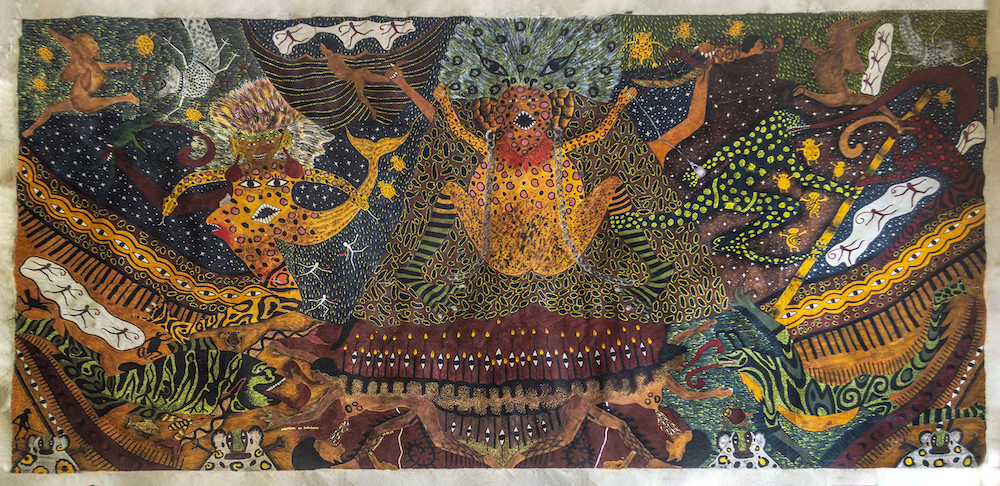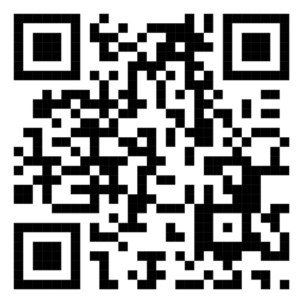SHIMINBRO, the Maker of Sound
Santiago Yahuarcani

The exhibition comprises large format paintings on vegetable fabric «llanchama» with natural dyes that have been specially transported from the district of Pebas, Loreto, for this exhibition. Santiago Yahuarcani will be present at the opening and will also give a brief lecture on his work.
This exhibition is part of the IV International Biennial of Contemporary Art of the South – BIENALSUR 2023.
Santiago Yahuarcani (Pucaurquillo, 1960) is not only a visual artist but also an indigenous leader of the Uitoto-Aimeni people. His work revolves around Amazonian ontologies and the actions that severely and systematically harmed the original peoples. His works on the suffering and ferocious exploitation of indigenous people during the rubber boom have had a profound impact on the national memory.
Santiago Yahuarcani has also dealt with issues of extractivist exploitation and documenting and expressing indigenous strategies against COVID-19 and other diseases. His most recent exhibitions include “El Lugar de los Espíritus” (“The Place of the Spirits”) (ICPNA 2019) and the group show “Amazonías” (Matadero – Madrid, 2019).
Santiago Yahuarcani’s works are in the collections of the Museo de Arte de Lima (Lima Museum of Art), the Museo de Arte de San Marcos (San Marcos Art Museum), the Reina Sofía Museum in Madrid and the Van Abbe Museum in the Netherlands. He has appeared in exhibitions in Latin America, the United States, Europe and Asia.
Text by the curator
In his workshop in the village of Pevas, on the banks of the Ampiyacú River at the mouth of the Amazon River, Santiago gets up early in the morning and with his machete in hand sets off in search of llanchama and natural dyes. He walks in silence stopping, every few minutes, when something catches his attention. At this time of the morning the bustle of the bush is inexhaustible: insects, frogs, birds, leaves, trees, streams, all greet the new day. Santiago is a small being in that vast world. He stops. He looks from one side to the other. In the thick bush, among hundreds of trees and shades of green, he finds one of the seven varieties of renaco (typical rainforest tree) from which he will extract the bark to later transform it into a vegetable fabric: the “llanchama”. Preparing the work and the natural dyes will take him a week. It is hard work and requires a lot of patience and expertise, but the result will be satisfactory.
“The nights become short when we talk about what and why to paint. Myths, stories, fables, tales, visions, dreams, experiences, realities, frustrations, hopes and illusions are in our heads. Jokes and laughter come and go in the darkness of this summer. In the evenings we turn to Grandfather Tobacco to think well, to cool our thoughts so that we can do good work”.
This is how paintings like “Shiminbro, the Maker of Sound” are born, this is a being that came to Santiago’s mind, from the search and the questioning to know the origin of silence. “The rubber ball” reminds us that before the arrival of the whites, back in the 18th century, the Uitotos were already aware of the benefits of this tree, and various activities were practised among clans, to fraternise and where they were rewarded with abundant food, drink, tobacco and coca: unfortunately this would not last forever, the unstoppable modernity arrived and showed us its fiercest and most merciless face and in a few years we became mere properties and slaves of the whites, and our territories were taken from us by external agents.
In these territories of myths and resistance, Santiago’s painting plays an extremely important role because he nourishes himself with the knowledge of his ancestors in dialogue with the present time and, in this way, he is in search of generating concepts, provoking questions and creating new ways of understanding the reality of this world that we all inhabit.
Rember Yahuarcani
13 June 2023







